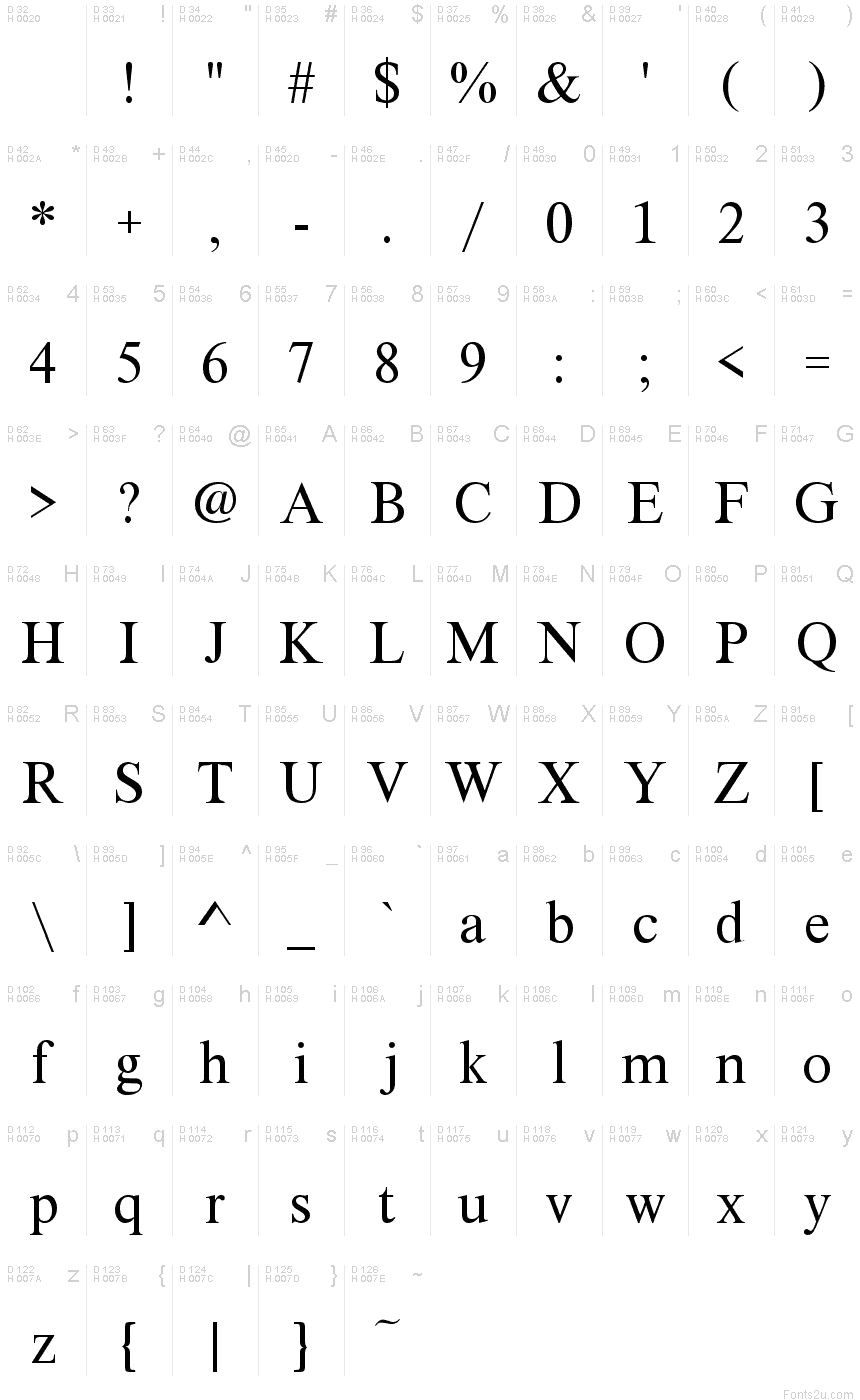XSerif Unicode
TrueTypeUsage privé
- Accents (partiel)
- Accents (complet)
xsuni.ttf
Mots clés
Table de caractères
Veuillez utiliser le menu déroulant pour visualiser de différents tableaux de caractères contenus dans cette police.

Informations sur les polices standards
Avis de droits d’auteur
(c) Ch. Singer 1997. Use Font Property Extension to read License table.
Famille de police
XSerif Unicode
Sous-famille de police
Regular
Identification unique de sous-famille
DTP- XSerif Unicode Version 1
Nom complet de police
XSerif Unicode
Version tableau de noms
Version 1.00
Nom de police postscript
XSerifUnicode
Avis de marque déposée
Created by Type-Designer 3.0
Nom du fabricant
Description
In addition to the codepages mentioned in "Charset/Unicode" table, this font contains Old Russian characters (Yat', Fita, Izhitsa) and combining diacritical marks with it's right UNICODE numbers.
There are also further characters used by Trediakovskij in 18 century and some characters for transliteration in user defined UNICODE area.
You can use these characters only if you have a UNICODE-based text processor (e.g. MS Word 97).
XSerif Typeface
When I wanted to create some special fonts for students of slavistics (e. g. for transliteration an Old Russian) I looked for a font with a "Times®"-like typeface that I could use as a base for my new fonts. But I found that all quality fonts are copyrighted and the quality of free and public domain fonts on Internet didn't please me, so I decided to create a new font with a slightly changed "Times®"-like typeface that I called "XSerif". Most common letters as "A" or "H" probably look like they do in every similar typeface, except slightly different poportions, serifs and weight, but some letters as cyrillic "zh" or cyrillic "l" are originally designed because I didn't like their shape in other "Times®"-like typefaces.
There is only Regular typeface existing at this time.
If you are looking for a base font to create fonts containig special characters you can use XSerif fonts under the two conditions described in "License" table.
There are also further characters used by Trediakovskij in 18 century and some characters for transliteration in user defined UNICODE area.
You can use these characters only if you have a UNICODE-based text processor (e.g. MS Word 97).
XSerif Typeface
When I wanted to create some special fonts for students of slavistics (e. g. for transliteration an Old Russian) I looked for a font with a "Times®"-like typeface that I could use as a base for my new fonts. But I found that all quality fonts are copyrighted and the quality of free and public domain fonts on Internet didn't please me, so I decided to create a new font with a slightly changed "Times®"-like typeface that I called "XSerif". Most common letters as "A" or "H" probably look like they do in every similar typeface, except slightly different poportions, serifs and weight, but some letters as cyrillic "zh" or cyrillic "l" are originally designed because I didn't like their shape in other "Times®"-like typefaces.
There is only Regular typeface existing at this time.
If you are looking for a base font to create fonts containig special characters you can use XSerif fonts under the two conditions described in "License" table.
Informations sur les polices étendues
Plateformes supportées
PlateformeCodage
MicrosoftUnicode BMP uniquement
MacintoshRomain
UnicodeUnicode 1.0 sémantique
Détails de la police
Créé1998-04-09
Révision1
Comptage des glyphes463
Unités par Em2048
Droits incorporationIncorporation pour installation permanente
Classe familleSérifs forme libre
PoidsMoyen léger
LargeurMoyen (normal)
LargeurNormal
Mac styleGras
DirectionSeulement glyphes fortement gauche-à droit
Caractéristiques des modèlesOrdinaire
PostureVerticale
Poids traitNormal, régulier, etc.
EspacementNon fixe